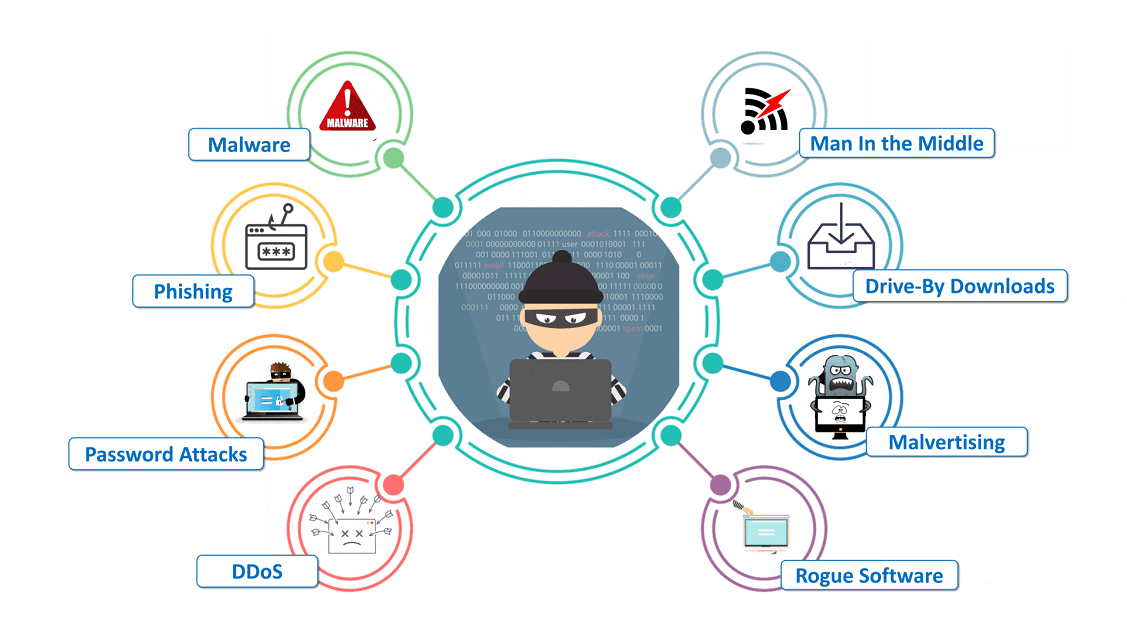
Today, cyberspace is the most apt platform for cyber criminals to carry out their operations. With the introduction of internet at every level of the workplace, the offices have developed a vulnerability which can be easily exploited by the online miscreants. Even, the common man has not been spared by such entities. Reports of hack attacks on individuals surface every day on the print as well as the digital media.
Precaution is better than cure holds true in the present scenario. Preventing such attacks from happening is the best measure one can resort to. And the first measure towards preventing such attacks from happening is knowing about the different types of cyber-attacks. So, keep reading to find out the various kinds of cyber-attacks.
1Malware Attacks
Malware Attacks
Malware is blanket-term which includes various threats like viruses, worms Trojans, etc. These are the self-executing codes designed to harm the victim’s system. Malware is introduced into the victim’s computer using different means like email attachments, download from malicious sites and in some cases even through infected flash/pen drives. Once attached, they pry on the system’s vulnerabilities to further deteriorate the system’s condition.
To combat the ever-evolving malware landscape, small businesses can benefit from employing robust cybersecurity software specifically tailored to their needs. Investing in a small business cybersecurity software means that organizations can proactively protect their sensitive data, thwart potential cyber threats, and minimize the risk of financial losses and reputational damage caused by malware attacks. By implementing such advanced security measures, companies can enhance their overall cybersecurity posture and establish a strong defense against the constantly evolving threat landscape.
2Phishing Scams
Phishing Scams
One of the oldest tricks in the book for the cyber-criminals. In this case, a malicious link is sent to the target’s email. Upon clicking, it directs the target to a phishing site (aesthetically similar to your email or social network site) where the target is required to put in his sensitive credentials. The credentials, put in, are then accessible to the hackers, and they may use them to their benefit.
3Password Attacks
Password Attacks
These attacks are targeted towards getting access to the victim’s passwords. The hackers employ different techniques like brute force attacks, or running of malicious codes, or using dictionary attacks to retrieve the victim’s passwords. In the case of success of any of these methods, the password comes into the hands of the cyber-criminals. Using a strong password and changing passwords at regular intervals seems to be the only defense against such attacks.
4DoS Attacks
DoS Attacks
Another type of cyber-attack used mainly against the corporates is the Denial of Services (DoS) attack. This method uses transmitting huge volume of traffic onto the victim’s network thereby disrupting the service by overloading it. An even more dangerous attack is the DDoS (Distributed-Denial-of-Services) attack where multiple computers are used to disrupt the services on similar lines.
5Malicious Advertising
Malicious Advertising
Ads are rampant on the internet. Malicious codes are inserted in such ads which are downloaded to your system upon clicking. These ads are put on prominent sections on a webpage prompting the users to click on these ads. Such ads may even be present on popular or legitimate sites where the users are completely unaware of the dangers that they lie.
6Man-in-the-Middle (MITM) Attack
Man-in-the-Middle (MITM) Attack
As the name says, a ‘man’ is present in between the endpoints and hence, any information entered by the victims are available to these entities. Usually, present on the transactional and business sites, the “man” can snoop all you information and use it to their advantage. They may even impersonate you banking sites and prompt you to fill in your sensitive data.
7Drive-By Downloads
Drive-By Downloads
You may be surprised to know that malicious code may be inserted into your system even by just visiting a website. A minute code is inserted into the victim’s computer which uses another computer to download the rest of its components. The code then uses the system’s or other programs’ (like Java, Flash) vulnerabilities to execute further.
End-note
There are other types of cyber-attacks too which couldn’t be covered in this article owing to the paucity of time. The readers are advised to look up other cyber-attacks like Rogue software attack, spyware attacks to better prevent against the cyber-attacks.
Readers must devise their security measures accordingly to counter the attempts of the cyber-criminals. The most important thing is to keep your eyes open and resort to stringent precautionary measure to immerse yourself completely in the cyber-world without any care.






